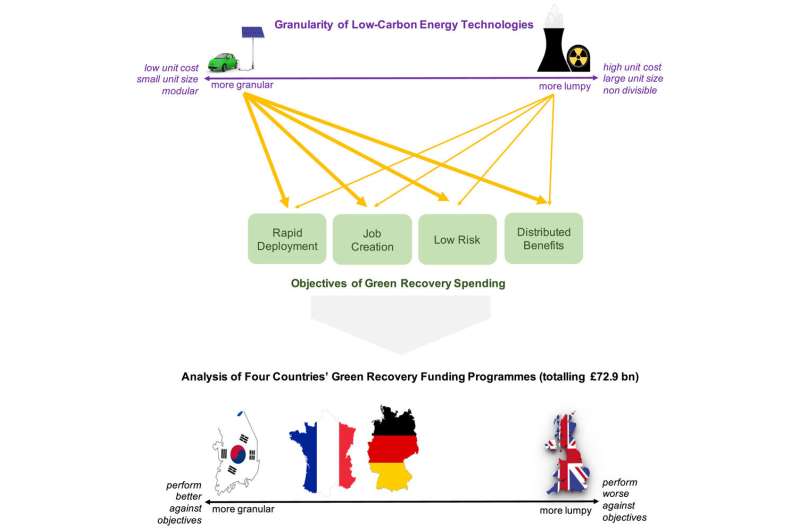
With the pandemic thankfully receding in the rearview mirror while the climate crisis looms ever larger in front of us, it’s worth remembering the calls from 2020 to “build back better.” A recent study investigated how we are progressing on achieving this ambitious goal.
In essence, the concept of “building back better” after a crisis entails the quick allocation of funds towards a green recovery, which simultaneously aids in job creation, stimulates economic activity, and contributes to the reduction of greenhouse gas (GHG) emissions in both the short and the long term.
In just four countries—France, Germany, South Korea, and the UK—€85 billion of public money was mobilized in 2020 for investment in low-carbon technologies and infrastructure to align fiscal stimulus with progress on decarbonization. With economies emerging from lockdowns, the emphasis for low-carbon investment choices should have been on speed, jobs, and distributing benefits widely.
Research shows that this can be effectively achieved through smaller-scale, granular technologies like solar panels, electric vehicles, and electrolyzers rather than larger-scale facilities like nuclear power and carbon capture storage that are slow to build, risky, and with few direct beneficiaries.
Against this technological granularity criterion, South Korea’s green recovery funding performed the best among the four countries mentioned above. The UK stood out in its choice to concentrate a large amount of investment in a small number of low-carbon megaprojects, with almost 25% of its entire low-carbon investment portfolio spent on technologies. For South Korea this was only 2%.
According to senior IIASA researcher Charlie Wilson, who is also a professor at Oxford University and co-author of the new paper recently published in the journal Joule, the response of governments to pandemic recovery was a unique opportunity to align massive fiscal stimulus with the urgent need to rapidly decarbonize energy systems while creating jobs.
“Our study shows how the technological ‘granularity’ of national investment portfolios captures multiple desirable characteristics of green recovery,” says Wilson.
“Portfolios weighted towards more granular or smaller-scale technologies and infrastructures are associated with more rapid deployment, with higher employment multipliers, and with more widely distributed social and environmental benefits,” adds co-author Simon De Stercke, a guest research scholar in the Integrated Assessment and Climate Change Research Group of the IIASA Energy, Climate, and Environment Program.
Of the 93 green funding programs the researchers analyzed across the four countries, South Korea’s “New Deal” portfolio took this granularity lesson most clearly on board by distributing its investments across large numbers of renewable, digital, and efficient energy technologies. At the other extreme, the UK allocated a significant proportion of its funding to energy and industrial technologies with unit costs exceeding hundreds of millions of pounds.
“Not only do these mega-scale projects have significant implementation risks and delayed benefits for decarbonization, but they also deliver fewer net jobs and distribute the benefits into fewer hands than more granular alternatives,” explains study co-author Caroline Zimm, a researcher in the Transformative Institutional and Social Solutions Research Group of the IIASA Energy, Climate, and Environment Program.
The researchers further highlight that despite the effectiveness of nature-based measures like tree planting and urban green spaces in creating jobs and reducing carbon emissions, they play a minor role in green recovery funding programs in the four countries studied. Each country’s recovery spending programs demonstrate path dependence, with priorities ranging from national industries and job protection to policy alignment and filling gaps in policy landscapes.
While solutions to global, systemic problems can never be simple, this latest paper as well as previous studies by Wilson and his colleagues provide compelling evidence that in many contexts, more granular energy technologies deploy faster, improve quicker, offer more ways to escape carbon lock-in, provide more equitable access, and create more jobs. In combination these advantages could enable the rapid technological change needed to tackle climate change.
“In the wake of the COVID-19 pandemic, the opportunity to steer economies towards low-carbon pathways through recovery spending has been missed. Yet, the pressing need to swiftly increase investment in low-carbon initiatives to attain the net-zero goals outlined in the Paris Agreement remains,” Wilson says. “By focusing on granular recovery spending, there is an opportunity to redirect existing path dependencies and accelerate progress towards decarbonization.”
More information:
Charlie Wilson et al, Building back better: Granular energy technologies in green recovery funding programs, Joule (2023). DOI: 10.1016/j.joule.2023.05.012
Citation:
Are we building back better yet? Study investigates granular energy technologies in green recovery funding programs (2023, June 26)
retrieved 26 June 2023
from https://techxplore.com/news/2023-06-granular-energy-technologies-green-recovery.html
This document is subject to copyright. Apart from any fair dealing for the purpose of private study or research, no
part may be reproduced without the written permission. The content is provided for information purposes only.
For all the latest Technology News Click Here
For the latest news and updates, follow us on Google News.

